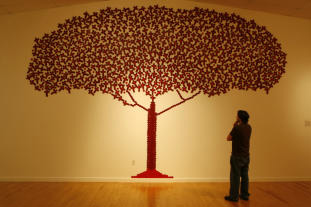 |
 |
 |
 Vallarta Living | Art Talk | November 2006 Vallarta Living | Art Talk | November 2006  
Frontera 450+ Speaks of Death, Hope
 Patricia C. Johnson - Houston Chronicle Patricia C. Johnson - Houston Chronicle


| | Tree of Life by Angela Dillon features small, blood-red wooden crosses representing murder victims. (Carlos Antonio Rios/Houston Chronicle) |
Sometimes, art is the most direct way to address an issue too hurtful, controversial or imprecise to deal with only in rational terms.

Consider femicide, the murder of women. It is one of the most brutal international crimes of our time. It's happening everywhere — the Middle East, Asia, Africa — and in Juárez, Mexico across from El Paso.

The murders in Juárez are the focus of Frontera 450+, an exhibit at the Station where an international group of 17 artists gives form to and voices protests against the vicious killings.

The exact number of women who have been murdered in the border city since 1993 is not known. In 1998, Mexican officials said there had been 95 deaths; feminist groups gave the number as 123, with many others listed as "disappeared."

The rape, mutilation and murder of young women in the city a bridge away from the U.S. continue today. The number of victims, which includes several American citizens, is now estimated at more than 400. They worked in the maquiladoras, manufacturing plants on the south side of the Rio Grande. Their ages were 14 to 23. They were slender and had long, dark hair.

Their tortured bodies are found discarded in the desert, in ditches, along roads. Many cannot be identified.

Officials have been unable (unwilling, some say) to find, much less stop, the murderers, and seem to have made finger pointing almost a sport: The perpetrators are the women's boyfriends or husbands, drug dealers, organ thieves. Arrests are few.

Print and electronic media have covered the killings regularly, but news reports may be insufficient. On the other hand, the exhibit at the Station gives immediacy and gritty, graphic presence to the violence.

The video by Teresa Serrano from Mexico City is emblematic. In it, a piñata in the shape of dark-haired young woman in a short skirt is beaten by a young man — viciously, over and over, as he grunts with the effort of destroying her.

Margarita Cabrera, from Monterrey, built a bin with rough wood planks, filled it with clothing of Juárez's victims and poured cement over them.

Susan Plum, an American artist living in Mexico, is represented by a videotaped performance in the city of Queretaro that was a symbolic limpia — spiritual cleansing. A group of women shout "Justicia!" "Justicia!" (Justice!) as they sweep the courtyard where a fountain is silent and candles burn.

Hundreds of small, blood-red wooden crosses shape Angela Dillon's large Tree of Life that covers one wall. A dozen large-scale color photographs by Maya Goded capture the grief of the slain women's families. Sara Maniero presents sepia-toned C-prints of dental X-rays in a sequence that suggests it is only a partial story.

Houstonian Sharon Kopriva's sculpture is as pithy an indictment of the harsh economic reality of the women's lives on the border as it is a powerful symbol of the abuse. Titled Who Are You, it consists of a small figure huddled in fetal position on a mound of sand, covered by produce sacks in green, yellow, white and red — in simulacrum of the Mexican flag. The artist states, "The girl wears only a produce sack. She is a Product of Mexico but her blood is on the hands of Mexico, the USA and the world."

Amid the horror are calls for consciousness and hope for healing.

Lise Bjorne of Denmark created an international project that involved nearly 400 women in countries from the Philippines to Norway, Mexico and the U.S. In groups of five or 10, the women embroidered the names of the Juárez victims or the word for "unknown" in their nation's language, on labels.

Bjorne pinned these small pieces of fabric — 1,023 of them — to the wall, individually arranging them with precision in four blocks of five lines each to form a musical score.

" I translated the Mexican national anthem into Morse code, letting the labels for the unknown be dots and the identified names the dashes," Bjorne said. Spaces between the labels serve as pauses.

"I wanted this to be more than a memorial. I also wanted it as a testament to what women do. The act of embroidering, which is so tactile and repetitive in motion, becomes a meditative way to connect to our own awareness and become open to connect to others."

FRONTERA 450+
• Where: The Station, 1502 Alabama at LaBranch; 713-529-6900 (Houston, TX)
• When: 11 a.m.-6 p.m. Wednesdays-Sundays. Through Jan. 28

patricia.johnson@chron.com | 
 | |
 |



